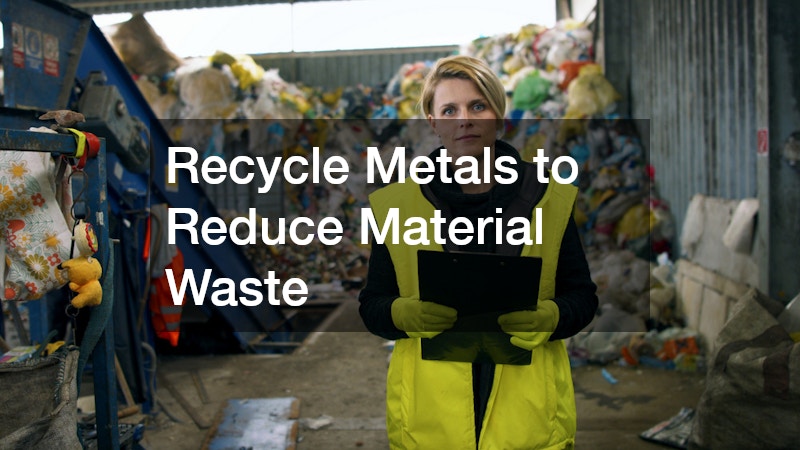Running a successful business today is about more than profits—it’s about sustainability, efficiency, and responsible operations. Companies that focus on reducing waste and optimizing processes not only save money but also build a strong reputation for environmental stewardship. This guide explores practical ways businesses can minimize waste and maximize efficiency, covering strategies from recycling initiatives to energy-efficient upgrades.
1. Recycle Metals to Reduce Material Waste

Many businesses generate a significant amount of scrap metal through manufacturing, construction, or the replacement of old equipment. Instead of sending these materials to landfills, partnering with metal recycling companies allows valuable resources such as steel, aluminum, and copper to be repurposed, extending their lifecycle and reducing environmental impact. Recycling metals not only helps conserve natural resources but also lowers the demand for energy-intensive mining and production of new materials.
Implementing a structured recycling program starts with identifying the types of metal your business produces and establishing designated collection points throughout your facility. Clear signage and containers for different metals can help employees separate materials efficiently, ensuring that everything collected is suitable for processing. Educating staff about the importance of proper disposal and the benefits of recycling encourages participation and minimizes contamination in the recycling stream.
Beyond environmental benefits, metal recycling can provide financial incentives. Many recycling companies offer payment for scrap metal, which can offset disposal costs and even generate additional revenue for the business. Tracking the amount of metal recycled over time also allows companies to measure progress toward sustainability goals and report environmental achievements to stakeholders.
By integrating metal recycling into daily operations, businesses not only reduce waste but also promote a culture of responsibility and efficiency. It’s a practical, cost-effective strategy that supports both the environment and the company’s bottom line, demonstrating that sustainability and profitability can go hand in hand.
2. Maximize Water Efficiency Across Operations
Water is one of the most essential resources for businesses across industries, from manufacturing and food services to offices and research facilities. Ensuring access to clean water is not only vital for operational efficiency but also for employee health, product quality, and environmental compliance. Contaminated or poorly managed water can disrupt processes, damage equipment, and even create safety hazards, making proper water management a top priority.
Implementing a comprehensive water management strategy begins with installing high-quality filtration systems to remove impurities and protect machinery and products. In addition to filtration, many businesses benefit from water recycling or reuse systems. These systems capture greywater from sinks, cooling units, or production processes and repurpose it for irrigation, cleaning, or non-potable industrial uses, reducing overall consumption and lowering utility costs.
Regular monitoring is critical to maintaining efficiency. Metering water usage in real-time helps identify spikes in consumption or hidden leaks, enabling prompt corrective action. Routine maintenance of pipes, valves, and tanks ensures the system operates effectively, while employee training encourages responsible usage habits throughout the facility.
Beyond operational benefits, prioritizing clean water demonstrates corporate responsibility and environmental stewardship. It can also help companies meet sustainability certifications, attract eco-conscious clients, and improve community relations. By proactively managing water resources, businesses not only reduce waste and save costs but also reinforce their commitment to sustainability and long-term operational resilience.
3. Choose Sustainable Options for Your Projects
Construction and renovation projects offer a prime opportunity to prioritize sustainability without compromising quality or design. By selecting building materials that are recycled, low-emission, or energy-efficient, businesses can significantly reduce their environmental footprint while contributing to a healthier planet. Reclaimed wood, bamboo, recycled steel, and low-VOC paints are excellent examples of materials that combine durability, aesthetic appeal, and sustainability.
Beyond the environmental benefits, sustainable materials often provide practical advantages. Energy-efficient insulation, windows, and roofing can reduce heating and cooling costs over the long term, while durable, recycled materials minimize the need for frequent replacements and maintenance. These choices also reflect positively on your business, demonstrating a commitment to corporate social responsibility and appealing to eco-conscious clients, partners, and employees.
Incorporating sustainable materials into your projects doesn’t require a complete overhaul of your construction processes. Even small changes, such as using recycled flooring or eco-friendly finishes, can make a meaningful difference. By thoughtfully planning material choices and sourcing responsibly, businesses not only enhance the quality and longevity of their projects but also help build a greener future. Sustainability becomes an integral part of your operations, proving that eco-friendly construction and smart business decisions can go hand in hand.
4. Protect Your Property with Smart Maintenance
A properly maintained roof is more than just a structural necessity — it plays a critical role in protecting your facility and improving energy efficiency. Partnering with professional roofing services ensures that your roof is installed correctly, insulated effectively, and properly waterproofed. These measures prevent leaks, water damage, and structural deterioration, saving your business from costly repairs down the line.
In addition to basic maintenance, modern roofing solutions offer eco-friendly benefits. Reflective coatings and energy-efficient materials help minimize heat absorption, reducing the workload on HVAC systems and lowering energy consumption. This not only cuts operating costs but also contributes to a smaller carbon footprint. Regular inspections by experienced roofing professionals can identify minor issues such as loose shingles, worn flashing, or minor leaks before they escalate into major problems.
Beyond energy and cost savings, investing in roof maintenance safeguards your employees, equipment, and inventory by preventing water damage and structural failures. Businesses that adopt a proactive approach to roof care demonstrate responsible facility management and a commitment to sustainability. By combining routine maintenance with smart material choices, your roof becomes a reliable barrier against the elements, supporting both operational efficiency and environmental responsibility.
5. Reduce Heat and Glare with Window Treatments

Excessive sunlight can create discomfort and drive up energy costs in commercial spaces. Installing window treatments, such as professional window tinting, helps control heat gain, reduce glare, and block harmful UV rays. This not only protects office furniture, flooring, and equipment from fading but also maintains a consistent indoor temperature, easing the load on HVAC systems and lowering utility bills.
Window treatments can also improve employee productivity and comfort by minimizing glare on computer screens and creating a more visually pleasant environment. Modern tinting solutions offer a sleek, professional look that enhances the building’s aesthetic while providing practical energy-saving benefits. Some advanced tints even have reflective or low-emissivity coatings that optimize insulation, keeping interiors cooler in summer and warmer in winter.
Implementing window treatments is a cost-effective, low-maintenance strategy for businesses looking to improve efficiency and sustainability. By addressing heat and glare, companies can extend the life of furnishings, reduce energy consumption, and create a more comfortable atmosphere for employees and clients alike. Small upgrades like these demonstrate a commitment to both operational efficiency and a well-managed, sustainable workspace.
6. Give Old Steel a New Life
Steel is one of the most widely used materials in industrial and construction settings, and leftover or scrap steel can accumulate quickly. Instead of sending it to landfills, partnering with steel recycling services allows businesses to repurpose these materials efficiently. Recycled steel can be melted down and used for new products, reducing the need for virgin resources and minimizing environmental impact.
Implementing a structured steel recycling program begins with creating designated collection points within your facility and training staff on proper sorting and handling procedures. Many recycling providers also offer pick-up services and weigh-ins, making it easier to track the amount of steel processed over time. Monitoring these metrics not only helps optimize operations but also provides tangible data for sustainability reporting and corporate responsibility initiatives.
Beyond environmental benefits, recycling steel can have financial advantages. Many facilities can sell scrap steel, generating revenue while reducing disposal costs. Additionally, using recycled steel in new projects often requires less energy than producing new steel, further enhancing operational efficiency.
By giving old steel a second life, businesses support a circular economy, reduce landfill contributions, and demonstrate a commitment to sustainable practices. A well-managed steel recycling program becomes both an operational asset and a visible statement of environmental responsibility to employees, clients, and the broader community.
7. Reuse Copper Components to Cut Costs
Copper is a highly versatile and valuable material found in wiring, tubing, and various electronic components. During facility upgrades, maintenance, or equipment replacements, copper is often discarded despite its potential for reuse. Implementing a copper recycling program allows businesses to reclaim these materials, turning what would be waste into a valuable resource. Recycled copper can be sold to scrap processors, reused in new projects, or melted down to produce new components, reducing the need for newly mined copper and lowering operational costs.
To maximize the effectiveness of copper recycling, companies should establish clearly marked drop-off points and collection bins throughout the facility. Training staff to identify, segregate, and handle copper safely ensures that the process is efficient and contamination-free. Regular audits of collected copper can also help track volumes, measure the program’s impact, and provide data for sustainability reporting.
Beyond cost savings, copper recycling contributes to environmental goals by reducing landfill waste, conserving natural resources, and minimizing energy consumption associated with mining and refining new copper. Many businesses find that integrating a copper recovery initiative strengthens their overall sustainability profile and demonstrates corporate responsibility to clients, investors, and employees.
By reusing copper components, businesses not only cut material expenses but also actively participate in a circular economy. With proper planning, staff engagement, and partnership with reliable recycling services, copper recovery becomes a practical, cost-effective, and environmentally responsible practice that benefits both the bottom line and the planet.
8. Transition to Renewable Fuel Sources
Fossil fuels are a major contributor to greenhouse gas emissions, driving climate change and increasing operational costs for businesses that rely on vehicles, generators, or heavy machinery. Transitioning to biodiesel or other renewable fuels offers a practical solution to reduce both environmental impact and fuel expenses. Biodiesel, made from renewable resources such as vegetable oils or animal fats, is compatible with many existing diesel engines, making the switch relatively seamless for fleets and industrial equipment without the need for extensive modifications.
Adopting renewable fuels provides multiple benefits beyond emissions reduction. Biodiesel burns cleaner than traditional diesel, resulting in fewer pollutants and improved air quality in and around your facility. Many businesses also report improved engine longevity and performance due to biodiesel’s lubricating properties, which help reduce wear and tear. Additionally, combining fuel transition with other sustainability initiatives, such as recycling programs and energy-efficient equipment, magnifies environmental and financial gains.
Implementing a renewable fuel strategy requires planning and collaboration with reliable suppliers to ensure consistent quality and supply. Monitoring fuel usage, maintaining equipment properly, and training staff on safe handling practices are essential steps for maximizing efficiency and benefits.
By transitioning to biodiesel or other renewable fuels, businesses not only lower their carbon footprint but also demonstrate a commitment to sustainable operations. This proactive approach supports corporate social responsibility, enhances brand reputation, and contributes to long-term cost savings while actively protecting the environment.
9. Consult Experts to Streamline Sustainability Practices
Successfully reducing waste and improving efficiency often requires more than ad-hoc efforts—it benefits from professional guidance. Partnering with an experienced environmental consultant provides businesses with expert insights into operations, helping identify inefficiencies and areas where sustainability measures can have the greatest impact. Consultants can conduct comprehensive audits, examining energy usage, water consumption, waste management, and material sourcing to develop a clear picture of a company’s environmental footprint.
With this information, consultants create tailored strategies that align with your business goals while maximizing environmental and financial benefits. They can recommend practical solutions such as optimizing energy systems, implementing recycling programs, improving supply chain sustainability, or upgrading equipment to more efficient models. Regulatory compliance is another critical area where expert guidance ensures that your business adheres to environmental laws, avoiding potential fines and reputational damage.
Environmental consultants also help set measurable goals, track progress, and provide ongoing support to maintain improvements. This structured approach ensures that sustainability initiatives are actionable, cost-effective, and integrated seamlessly into daily operations.
Engaging a professional allows businesses to make informed decisions, prioritize initiatives, and implement long-term solutions without disrupting productivity. By leveraging expert advice, companies can strengthen their sustainability practices, reduce operational waste, and demonstrate a genuine commitment to environmental responsibility, all while supporting efficiency, cost savings, and corporate reputation.
10. Safely Dispose of Sensitive Materials
Every business generates sensitive documents and materials that require careful handling. Failing to dispose of them properly can lead to data breaches, identity theft, or compliance violations. Partnering with professional paper shredding services ensures that confidential paperwork is destroyed securely and efficiently. These services use industrial-grade shredders and follow strict protocols, giving you peace of mind that sensitive information won’t fall into the wrong hands.
Beyond security, shredding supports responsible waste management. Shredded paper can often be recycled, reducing landfill contributions and promoting a more sustainable office or industrial environment. By integrating shredding into regular operations, businesses create a consistent, circular process that safeguards information while benefiting the planet.
Regularly scheduled shredding also improves organization. Cluttered offices not only pose security risks but also reduce productivity and create fire hazards. Establishing a routine—weekly, monthly, or as needed—helps maintain a tidy workspace while keeping sensitive materials under control.
Moreover, demonstrating proper disposal practices communicates a strong commitment to both safety and sustainability. Employees, clients, and stakeholders recognize that the business prioritizes data protection and environmental responsibility. By combining secure destruction with recycling initiatives, companies can protect their information, enhance operational efficiency, and contribute positively to broader environmental goals. Properly managing sensitive materials is a simple yet powerful step toward a safer, more sustainable workplace.
Conclusion
Reducing waste and boosting efficiency isn’t just an environmental initiative—it’s a business strategy. From recycling metals and copper to investing in renewable fuels and sustainable materials, every step contributes to a greener, more cost-effective operation. Simple upgrades like window tinting, roof maintenance, and paper shredding improve both efficiency and workplace safety.
By leveraging professional services, consulting experts, and integrating smart operational practices, businesses can create systems that save money, protect the environment, and enhance long-term resilience. Sustainability becomes a tangible advantage rather than a compliance burden, helping companies thrive in a market that increasingly values responsibility and innovation.
Implement these strategies today, and your business can achieve the dual goal of operational efficiency and environmental stewardship—protecting resources, reducing waste, and building a reputation as a forward-thinking, sustainable organization.

